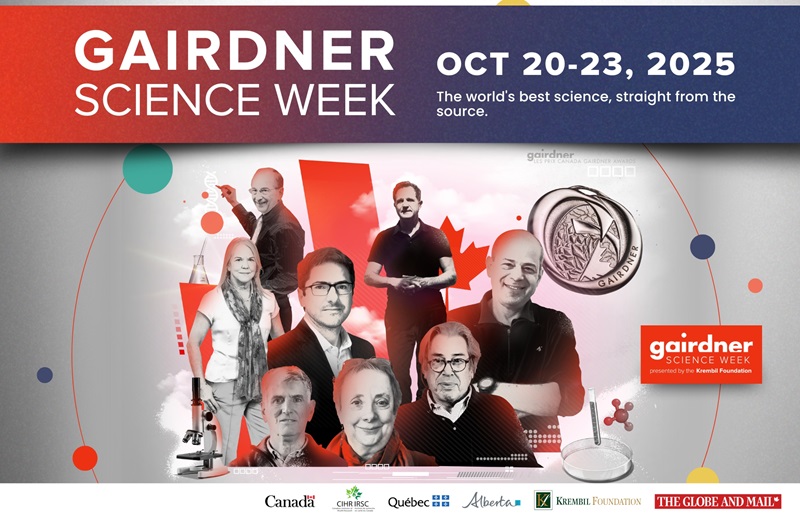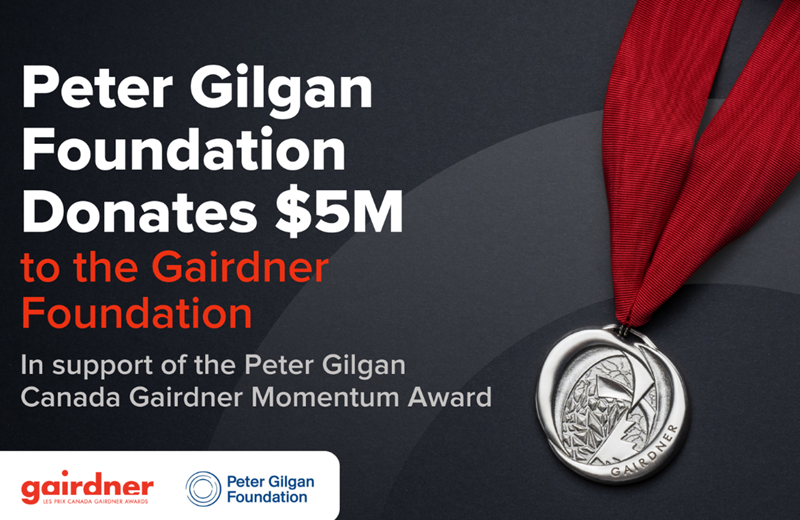2020 Canada Gairdner Award Winners Announced

2020 Canada Gairdner Awards recognize world-renowned scientists for transformative contributions to research that impact human health.
Download EN Press Release- 2020 CANADA GAIRDNER AWARDS ANNOUNCED
Download FR Communiqué de presse - LES PRIX CANADA GAIRDNER 2020
TORONTO, ON (March 31 2020) – The Gairdner Foundation is pleased to announce the 2020 Canada Gairdner Award laureates, recognizing some of the world’s most significant biomedical research and discoveries. During these challenging times, we believe it is important to celebrate scientists and innovators from around the world and commend them for their tireless efforts to conduct research that impacts human health.
2020 Canada Gairdner International Award
The five 2020 Canada Gairdner International Award laureates are recognized for seminal discoveries or contributions to biomedical science:
Dr. Masatoshi Takeichi
Senior Visiting Scientist, RIKEN Center for Biosystems Dynamics Research, Kobe, Japan; Professor Emeritus, Kyoto University, Kyoto, Japan
Dr. Rolf Kemler
Emeritus Member and Director, Max Planck Institute of Immunobiology and Epigenetics, Freiburg, Germany
Awarded "For their discovery, characterization and biology of cadherins and associated proteins in animal cell adhesion and signalling."
Dr. Takeichi
The Work:
The animal body is made up of numerous cells. Dr. Takeichi was investigating how animal cells stick together to form tissues and organs and identified a key protein that he named ‘cadherin’. Cadherin is present on the surface of a cell and binds to the same cadherin protein on the surface of another cell through like-like interaction, thereby binding the cells together. Without cadherin, cell to cell adhesion becomes weakened and leads to the disorganization of tissues. Dr. Takeichi found that there are multiple kinds of cadherin within the body, each of which is made by different cell types, such as epithelial and neuronal cells. Cells with the same cadherins tend to cluster together, explaining the mechanism of how different cells are sorted out and organized to form functional organs.
Further studies by Dr. Takeichi’s group showed that cadherin function is supported by a number of cytoplasmic proteins, including catenins, and their cooperation is essential for shaping tissues. His studies also revealed that the cadherin-dependent adhesion mechanism is involved in synaptic connections between neurons, which are important for brain wiring.
The Impact:
The discovery of cadherins, which are found in all multicellular animal species, has allowed us to interpret how multicellular systems are generated and regulated. Loss of cadherin function has been implicated as the cause of certain cancers, as well as in the invasiveness of many cancers. Mutations in special types of cadherin result in neurological disorders, such as epilepsy and hearing loss. The knowledge of cadherin function is expected to contribute to the development of effective treatments against such diseases.
Dr. Kemler
The Work:
Dr. Kemler, using an immunological approach, developed antibodies directed against surface antigens of early mouse embryos. These antibodies were shown to prevent compaction of the mouse embryo and interfered with subsequent development. Both Dr. Kemler and Dr. Takeichi went on to clone and sequence the gene encoding E-cadherin and demonstrate that it was governing homophilic cell adhesion.
Dr. Kemler also discovered the other proteins that interact with the cadherins, especially the catenins, to generate the machinery involved in animal cell-to-cell adhesion. This provided the first evidence of their importance in normal development and diseases such as cancer. It has been discovered that cadherins and catenins are correlated to the formation and growth of some cancers and how tumours continue to grow. Beta-catenin is linked to cell adhesion through interaction with cadherins but is also a key component of the Wnt signalling pathway that is involved in normal development and cancer. There are approximately 100 types of cadherins, known as the cadherin superfamily.
The Impact:
Human tumours are often of epithelial origin. Given the role of E-cadherin for the integrity of an epithelial cell layer, the protein can be considered a suppressor of tumour growth. The research on the cadherin superfamily has had a great impact on fields as diverse as developmental biology, cell biology, oncology, immunology and neuroscience. Mutations in cadherins/catenins are frequently found in tumours. Various screens are being used to identify small molecules that might restore cell adhesion as a potential cancer therapy.
Dr. Roel Nusse
Professor & Chair, Department of Developmental Biology; Member, Institute for Stem Cell Biology and Regenerative Medicine, Stanford University, School of Medicine. Virginia and Daniel K. Ludwig Professor of Cancer Research. Investigator, Howard Hughes Medical Institute
Awarded “For pioneering work on the Wnt signalling pathway and its importance in development, cancer and stem cells”
The Work:
Dr. Nusse’s research has elucidated the mechanism and role of Wnt signalling, one of the most important signalling systems in development. There is now abundant evidence that Wnt signalling is active in cancer and in control of proliferation versus differentiation of adult stem cells, making the Wnt pathway one of the paradigms for the fundamental connections between normal development and cancer.
Among Dr. Nusse’s contributions is the original discovery of the first Wnt gene (together with Harold Varmus) as an oncogene in mouse breast cancer. Afterwards, Dr. Nusse identified the Drosophila Wnt homolog as a key developmental gene, Wingless. This led to the general realization of the remarkable links between normal development and cancer, now one of the main themes in cancer research. Using Drosophila genetics, he established the function of beta-catenin as a mediator of Wnt signalling and the Frizzleds as Wnt receptors (with Jeremy Nathans), thereby establishing core elements of what is now called the Wnt pathway. A major later accomplishment of his group was the first successful purification of active Wnt proteins, showing that they are lipid-modified and act as stem cell growth factors.
The Impact:
Wnt signalling is implicated in the growth of human embryos and the maintenance of tissues. Consequently, elucidating the Wnt pathway is leading to deeper insights into degenerative diseases and the development of new therapeutics. The widespread role of Wnt signalling in cancer is significant for the treatment of the disease as well. Isolating active Wnt proteins has led to the use of Wnts by researchers worldwide as stem cell growth factors and the expansion of stem cells into organ-like structures (organoids).
Dr. Mina J. Bissell
Distinguished Senior Scientist, Biological Systems and Engineering Division, Lawrence Berkeley National Laboratory; Faculty; Graduate Groups in Comparative Biochemistry, Endocrinology, Molecular Toxicology and Bioengineering, University of California Berkeley, Berkeley, CA, USA
Awarded “For characterizing “Dynamic Reciprocity” and the significant role that extracellular matrix (ECM) signaling and microenvironment play in gene regulation in normal and malignant cells, revolutionizing the fields of oncology and tissue homeostasis.”
The Work:
Dr. Mina Bissell’s career has been driven by challenging established paradigms in cellular and developmental biology. Through her research, Dr. Bissell showed that tissue architecture plays a dominant role in determining cell and tissue phenotype and proposed the model of ‘dynamic reciprocity’ (DR) between the extracellular matrix (ECM) and chromatin within the cell nucleus. Dynamic reciprocity refers to the ongoing, bidirectional interaction between cells and their microenvironment. She demonstrated that the ECM could regulate gene expression just as gene expression could regulate ECM and that these two phenomena could occur concurrently in normal or diseased tissue.
She also developed 3D culture systems to study the interaction of the microenvironment and tissue organization and growth, using the mammary gland as a model.
The Impact:
Dr. Bissell’s model of dynamic reciprocity has been proven and thoroughly established since its proposal three decades ago and the implications have permeated every area of cell and cancer biology, with significant implications for current and future therapies. Dr. Bissell’s work has generated a fundamental and translationally crucial paradigm shift in our understanding of both normal and malignant tissues.
Her findings have had profound implications for cancer therapy by demonstrating that tumour cells can be influenced by their environment and are not just the product of their genetic mutations. For example, cells from the mammary glands grown in two-dimensional tissue cultures rapidly lose their identity, but once placed in proper three-dimensional microenvironments, they regain mammary form and function. This work presages the current excitement about the generation of 3D tissue organoids and demonstrates Dr. Bissell’s creative and innovative approach to science.
Dr. Elaine Fuchs
Howard Hughes Medical Institute Investigator and Rebecca C. Lancefield Professor and Head of the Robin Chemers Neustein Laboratory of Mammalian Cell Biology and Cell Biology; The Rockefeller University, New York, NY, USA
Awarded “For her studies elucidating the role of tissue stem cells in homeostasis, wound repair, inflammation and cancer.”
The Work:
Dr. Fuchs has used skin to study how the tissues of our body are able to replace dying cells and repair wounds. The skin must replenish itself constantly to protect against dehydration and harmful microbes. In her research, Fuchs showed that this is accomplished by a resident population of adult stem cells that continually generates a shell of indestructible cells that cover our body surface.
In her early research, Fuchs identified the proteins—keratins—that produce the iron framework of the skin’s building blocks and showed that mutations in keratins are responsible for a group of blistering diseases in humans. In her later work, Fuchs identified the signals that prompt skin stem cells to make tissue and when to stop. In studying these processes, Fuchs learned that cancers hijack the fundamental mechanisms that tissue stem cells use to repair wounds. Her team pursued this parallel and isolated and characterized the malignant stem cells that are responsible for propagating a type of cancer called “squamous cell carcinoma.” In her most recent work, she showed that these cells can be resistant to chemotherapies and immunotherapies and lead to tumour relapse.
The Impact:
All tissues of our body must be able to replace dying cells and repair local wounds. Skin is particularly adept at performing these tasks. The identification and characterization of the resident skin stem cells that make and replenish the epidermis, sweat glands and hair provide important insights into this fountain of youth process and hold promise for regenerative medicine and aging. In normal tissues, the self-renewing ability of stem cells to proliferate is held in check by local inhibitory signals coming from the stem cells’ neighbours. In injury, stimulatory signals mobilize the stem cells to proliferate and repair the wound. In aging, these normal balancing cues are tipped in favour of quiescence. In inflammatory disorders, stem cells become hyperactivated. In cancers, the wound mechanisms to mobilize stem cells are hijacked, leading to uncontrolled tissue growth. Understanding the basic mechanisms controlling stem cells in their native tissue is providing new strategies for searching out refractory tumour cells in cancer and for restoring normalcy in inflammatory conditions.
2020 John Dirks Canada Gairdner Global Health Award
The 2020 John Dirks Canada Gairdner Global Health Award laureate is recognized for outstanding achievements in global health research:
Professor Salim S. Abdool Karim
Director of CAPRISA (Centre for the AIDS Program of Research in South Africa), the CAPRISA Professor in Global Health at Columbia University, New York and Pro-Vice-Chancellor (Research) at the University of KwaZulu-Natal, Durban, South Africa
Professor Quarraisha Abdool Karim
Associate Scientific Director of CAPRISA, Professor in Clinical Epidemiology, Columbia University, New York and Professor in Public Health at the Nelson Mandela Medical School and Pro-Vice-Chancellor (African Health) at the University of KwaZulu-Natal, Durban, South Africa
Awarded “For their discovery that antiretrovirals prevent sexual transmission of HIV, which laid the foundations for pre-exposure prophylaxis (PrEP), the HIV prevention strategy that is contributing to the reduction of HIV infection in Africa and around the world.”
The Work:
UNAIDS estimates that 37 million people were living with HIV and 1.8 million people acquired HIV in 2017. In Africa, which has over two-thirds of all people with HIV, adolescent girls and young women have the highest rates of new HIV infections. ABC (Abstinence, Be faithful, and use Condoms) prevention messages have had little impact – due to gender power imbalances, young women are often unable to successfully negotiate condom use, insist on mutual monogamy, or convince their male partners to have an HIV test.
In responding to this crisis, Salim and Quarraisha Abdool Karim started investigating new HIV prevention technologies for women about 30 years ago. After two unsuccessful decades, their perseverance paid off when they provided proof of concept that antiretrovirals prevent sexually acquired HIV infection in women. Their ground-breaking CAPRISA 004 trial showed that tenofovir gel prevents both HIV infection and genital herpes. The finding was ranked in the “Top 10 Scientific Breakthroughs of 2010” by the journal, Science. The finding was heralded by UNAIDS and the World Health Organization (WHO) as one of the most significant scientific breakthroughs in AIDS and provided the first evidence for what is today known as HIV pre-exposure prophylaxis (PrEP).
The Abdool Karims have also elucidated the evolving nature of the HIV epidemic in Africa, characterizing the key social, behavioural and biological risk factors responsible for the disproportionately high HIV burden in young women. Their identification of the “Cycle of HIV Transmission”, where teenage girls acquire HIV from men about 10 years older on average, has shaped UNAIDS policies on HIV prevention in Africa.
The impact:
CAPRISA 004 and several clinical trials of oral tenofovir led to the WHO recommending a daily tenofovir-containing pill for PrEP as a standard HIV prevention tool for all those at high risk a few years later. Several African countries are among the 68 countries across all continents that are currently making PrEP available for HIV prevention. The research undertaken in Africa by this South African couple has played a key role in shaping the local and global response to the HIV epidemic.
2020 Canada Gairdner Wightman Award
The 2020 Canada Gairdner Wightman Award laureate is a Canadian scientist recognized for outstanding leadership in medicine and medical science throughout their career:
Dr. Guy Rouleau
Director of the Montreal Neurological Institute-Hospital (The Neuro); Professor & Chair of the Department of Neurology and Neurosurgery, McGill University; Director of the Department of Neuroscience, McGill University Health Center
Awarded “For identifying and elucidating the genetic architecture of neurological and psychiatric diseases, including ALS, autism and schizophrenia, and his leadership in the field of Open Science.”
The Work:
Dr. Rouleau has identified over 20 genetic risk factors predisposing to a range of brain disorders, both neurological and psychiatric, involving either neurodevelopmental processes or degenerative events. He has defined a novel disease mechanism for diseases related to repeat expansions that are at play in some of the most severe neurodegenerative conditions. He has significantly contributed to the understanding of the role of de novo variants in autism and schizophrenia. In addition, he has made important advances for various neuropathies, in particular for amyotrophic lateral sclerosis (ALS) where he was involved in the identification of the most prevalent genetic risk factors -which in turn are now the core of innumerable ALS studies worldwide.
Dr. Rouleau has also played a pioneering role in the practice of Open Science (OS), transforming the Montreal Neurological Institute-Hospital (The Neuro) into the first OS institution in the world. The Neuro now uses OS principles to transform research and care and accelerate the development of new treatments for patients through Open Access, Open Data, Open Biobanking, Open Early Drug Discovery and non-restrictive intellectual property.
The Impact:
The identification of genetic risk factors has a number of significant consequences. First, allowing for more accurate genetic counselling, which reduces the burden of disease to affected individuals, parents and society. A revealing case is Andermann syndrome, a severe neurodevelopmental and neurodegenerative condition that was once relatively common in the Saguenay-Lac-St-Jean region of Quebec. Now this disease has almost disappeared from that population. Second, identifying the causative gene allows the development of treatments. For instance, his earlier work on a form of ALS linked to the superoxide dismutase-1 gene (SOD1) opened up studies that are now the focal point of phase 2 clinical studies showing great promise.
By acting as a living lab for the last couple of years, The Neuro is spearheading the practice of Open Science (OS). The Neuro is also engaging stakeholders across Canada with the goal of formalizing a national OS alliance for the neurosciences. Dr. Rouleau’s work in OS contributes fundamentally to the transformation of the very ecosystem of science by stimulating new thinking and fostering communities of sharing. Inspired by The Neuro’s vision, the global science community is reflecting on current research conventions and collaborative projects, and the momentum for OS is gaining a foothold in organizations and institutions in all corners of the earth.
About the Gairdner Foundation:
The Gairdner Foundation was established in 1957 by Toronto stockbroker, James Gairdner to award annual prizes to scientists whose discoveries have had a major impact on scientific progress and on human health. Since 1959 when the first awards were granted, 387 scientists have received a Canada Gairdner Award and 92 to date have gone on to receive the Nobel Prize. The Canada Gairdner Awards promote a stronger culture of research and innovation across the country through our Outreach Programs including lectures and research symposia. The programs bring current and past laureates to a minimum of 15 universities across Canada to speak with faculty, trainees and high school students to inspire the next generation of researchers. Annual research symposia and public lectures are organized across Canada to provide Canadians access to leading science through Gairdner’s convening power.
For further information please contact:
Sommer Wedlock
Vice President & Director of Communications
MaRS Centre, Heritage Building
101 College Street, Suite 335
Toronto, Ontario. M5G 1L7
Office: (416) 596-9996 ext. 202
Mobile: (647) 293-6785
sommer@gairdnersommer@gairdner.org.org









.tmb-cfthumb_fb.jpg?Culture=en&sfvrsn=c0e04058_1)





